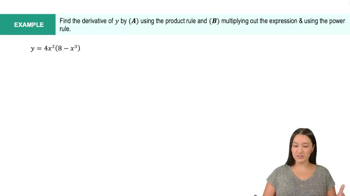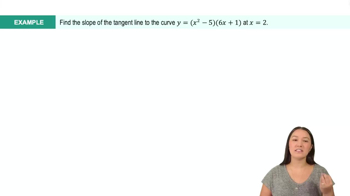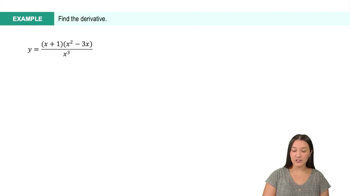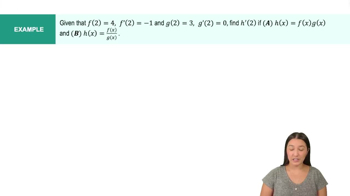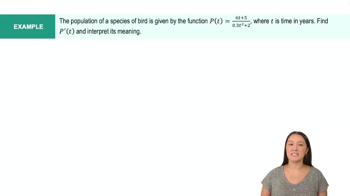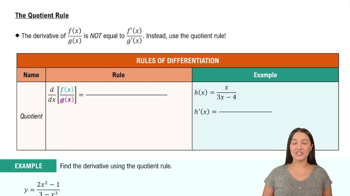Table of contents
- 0. Functions7h 52m
- Introduction to Functions16m
- Piecewise Functions10m
- Properties of Functions9m
- Common Functions1h 8m
- Transformations5m
- Combining Functions27m
- Exponent rules32m
- Exponential Functions28m
- Logarithmic Functions24m
- Properties of Logarithms34m
- Exponential & Logarithmic Equations35m
- Introduction to Trigonometric Functions38m
- Graphs of Trigonometric Functions44m
- Trigonometric Identities47m
- Inverse Trigonometric Functions48m
- 1. Limits and Continuity2h 2m
- 2. Intro to Derivatives1h 33m
- 3. Techniques of Differentiation3h 18m
- 4. Applications of Derivatives2h 38m
- 5. Graphical Applications of Derivatives6h 2m
- 6. Derivatives of Inverse, Exponential, & Logarithmic Functions2h 37m
- 7. Antiderivatives & Indefinite Integrals1h 26m
- 8. Definite Integrals4h 44m
- 9. Graphical Applications of Integrals2h 27m
- 10. Physics Applications of Integrals 2h 22m
3. Techniques of Differentiation
Product and Quotient Rules
Problem 99a
Textbook Question
Product Rule for three functions Assume f, g, and h are differentiable at x.
a. Use the Product Rule (twice) to find a formula for d/dx (f(x)g(x)h(x)).
 Verified step by step guidance
Verified step by step guidance1
Step 1: Recall the Product Rule for two functions, which states that if u(x) and v(x) are differentiable functions, then the derivative of their product is given by \( \frac{d}{dx}[u(x)v(x)] = u'(x)v(x) + u(x)v'(x) \).
Step 2: To find the derivative of the product of three functions \( f(x)g(x)h(x) \), first consider \( u(x) = f(x) \) and \( v(x) = g(x)h(x) \). Apply the Product Rule to these two functions.
Step 3: Differentiate \( v(x) = g(x)h(x) \) using the Product Rule again. Let \( u(x) = g(x) \) and \( v(x) = h(x) \), so \( \frac{d}{dx}[g(x)h(x)] = g'(x)h(x) + g(x)h'(x) \).
Step 4: Substitute the result from Step 3 into the expression obtained in Step 2. This gives \( \frac{d}{dx}[f(x)g(x)h(x)] = f'(x)g(x)h(x) + f(x)(g'(x)h(x) + g(x)h'(x)) \).
Step 5: Simplify the expression from Step 4 to obtain the final formula: \( \frac{d}{dx}[f(x)g(x)h(x)] = f'(x)g(x)h(x) + f(x)g'(x)h(x) + f(x)g(x)h'(x) \).
 Verified video answer for a similar problem:
Verified video answer for a similar problem:This video solution was recommended by our tutors as helpful for the problem above
Video duration:
9mPlay a video:
Was this helpful?
Key Concepts
Here are the essential concepts you must grasp in order to answer the question correctly.
Product Rule
The Product Rule is a fundamental principle in calculus used to differentiate products of functions. It states that if you have two differentiable functions, f(x) and g(x), the derivative of their product is given by d/dx [f(x)g(x)] = f'(x)g(x) + f(x)g'(x). This rule can be extended to more than two functions, allowing for the differentiation of products involving three or more functions.
Recommended video:
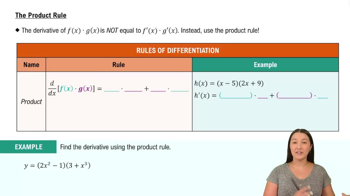
The Product Rule
Differentiability
A function is said to be differentiable at a point if it has a defined derivative at that point, meaning it has a tangent line that is not vertical. Differentiability implies continuity, but not vice versa. For the Product Rule to apply, all functions involved must be differentiable at the point of interest, ensuring that their derivatives can be computed and combined appropriately.
Recommended video:

Finding Differentials
Chain of Derivatives
When applying the Product Rule to multiple functions, it is essential to understand how to manage the derivatives of each function in the product. For three functions, f(x), g(x), and h(x), the derivative is found by applying the Product Rule iteratively. This involves taking the derivative of one function while keeping the others constant, and then summing the results, which requires careful organization of terms to ensure all combinations are accounted for.
Recommended video:

Intro to the Chain Rule
Related Videos
Related Practice



